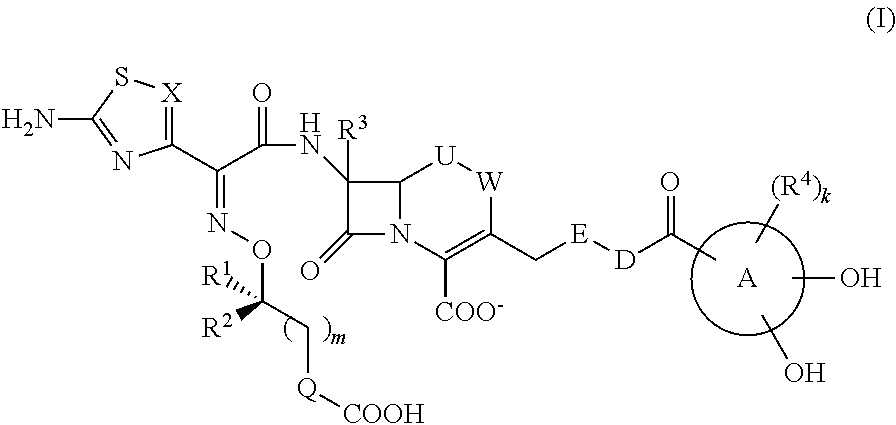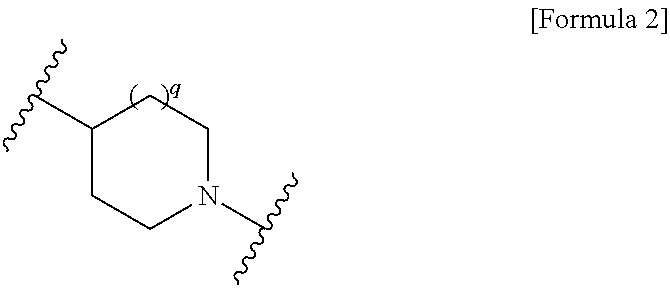Cephem compound having pseudo-catechol group
a technology of pseudo-catechols and compounds, applied in the field of cephem compounds, can solve problems such as clinical problems
- Summary
- Abstract
- Description
- Claims
- Application Information
AI Technical Summary
Benefits of technology
Problems solved by technology
Method used
Image
Examples
example 1
Synthesis of Compound (I-1)
[0198]
Step (1): Compound 1a→Compound 1b
[0199]To ice-cooled tetrahydrofuran (40 mL), lithium aluminum hydride (1.52 g, 40 mmol) followed by compound 1a (2.72 g, 20 mmol) were added. After heating at reflux for 45 minutes, the reaction solution was cooled in an ice bath. Sodium sulfate decahydrate was then added thereto until effervescence ceased. Anhydrous sodium sulfate (5.0 g) was then added, subsequently stirring at room temperature for 1 hour. After the insoluble was filtered off through a Celite, the resulting filtrate was Concentrated and then dried to yield Compound 1b (2.61 g, 93% yield) as a colorless liquid.
[0200]1H-NMR (CDCl3) δ: 1.36 (6H, t, J=7.5 Hz), 2.43 (2H, s), 2.91 (6H, q, J=7.5 Hz).
Step (2): Compound 1c→Compound 1d
[0201]Sodium chlorite (3.87 g, 42.7 mmol) was dissolved in water (20 mL). Under ice-cooling, a solution of amidosulfuric acid (9.15 g, 42.7 mmol) and Compound 1c (4.45 g, 17.1 mmol) in methanol (50 mL) was added thereto, and the...
example 2
Synthesis of Compound (I-2)
[0212]
Step (1): Compound 2a→Compound (I-2)
[0213]Compound I-2 (305 mg, 52% yield) was obtained as described in Example 1 using Compound 2a (637 mg, 0.80 mmol).
[0214]1H-NMR (D2O) δ: 1.48 (3H, s), 1.50 (3H, s), 1.92 (6H, t, J=7.5 Hz), 3.36-3.49 (9H, m), 3.85-3.91 (1H, m), 4.57 (1H, d, J=13.5 Hz), 5.34 (1H, d, J=5.1 Hz), 5.86 (1H, d, J=5.1 Hz), 6.96 (1H, s), 7.09 (1H, s), 7.72 (1H, s).
[0215]Elemental analysis for C31H35N8NaO10S2.6.1 H2O.0.4NaHCO3
[0216]Calcd.: C, 41.38; H, 5.33; N, 12.55; 5, 7.29; Na, 3.68(%).
[0217]Found.: C, 41.43; H, 5.27; N, 12.31; S, 7.05; Na, 3.54(%).
example 3
Synthesis of Compound (I-3)
[0218]
Step (1): Compound 3a→Compound 3c
[0219]To a solution of Compound 3a (561 mg, 4.0 mmol) in ethanol (0.5 mL), Compound 3b (404 mg) was added, and then heated at reflux for 20 hours. After the solvent was evaporated, the residue was diluted with chloroform, and then washed with water. The organic layer was dried with anhydrous magnesium sulfate, filtered, and then concentrated. Isopropyl acetate was added to the residue. The resulting precipitated solid was filtered, and then dried to yield Compound 3c (312 mg, 48% yield).
[0220]1H-NMR (CDCl3) δ: 1.22 (6H, t, J=8.4 Hz), 2.91 (6H, t, J=8.4 Hz), 3.44 (2H, s), 5.22 (2H, s), 6.41 (1H, d, J=7.5 Hz), 6.66 (1H, d, J=2.1 Hz), 6.98 (1H, dd, J=2.1, 7.5 Hz), 7.26-7.39 (5H, m).
Step (2): Compound 3d→Compound (I-3)
[0221]To a solution of Compound 3d (444 mg, 0.50 mmol) in N,N-dimethylformamide (2.0 mL), Compound 3c (162 mg, 0.50 mmol) was added under ice-cooling. After the reaction solution was stirred for 3 hours in a...
PUM
| Property | Measurement | Unit |
|---|---|---|
| Dynamic viscosity | aaaaa | aaaaa |
| Antimicrobial properties | aaaaa | aaaaa |
Abstract
Description
Claims
Application Information
 Login to View More
Login to View More - R&D
- Intellectual Property
- Life Sciences
- Materials
- Tech Scout
- Unparalleled Data Quality
- Higher Quality Content
- 60% Fewer Hallucinations
Browse by: Latest US Patents, China's latest patents, Technical Efficacy Thesaurus, Application Domain, Technology Topic, Popular Technical Reports.
© 2025 PatSnap. All rights reserved.Legal|Privacy policy|Modern Slavery Act Transparency Statement|Sitemap|About US| Contact US: help@patsnap.com



